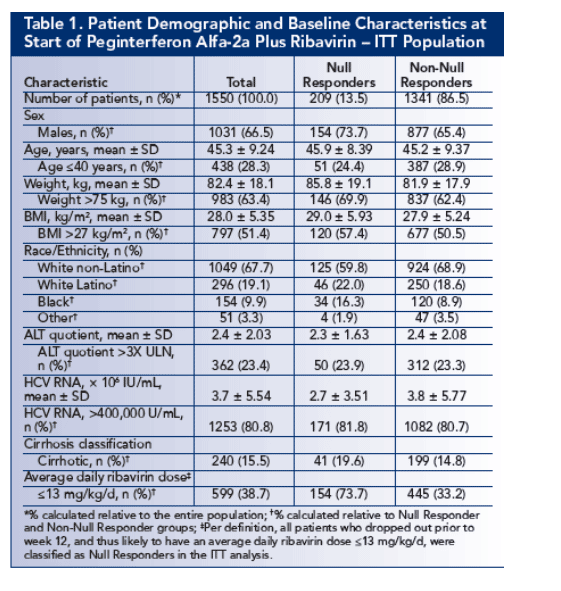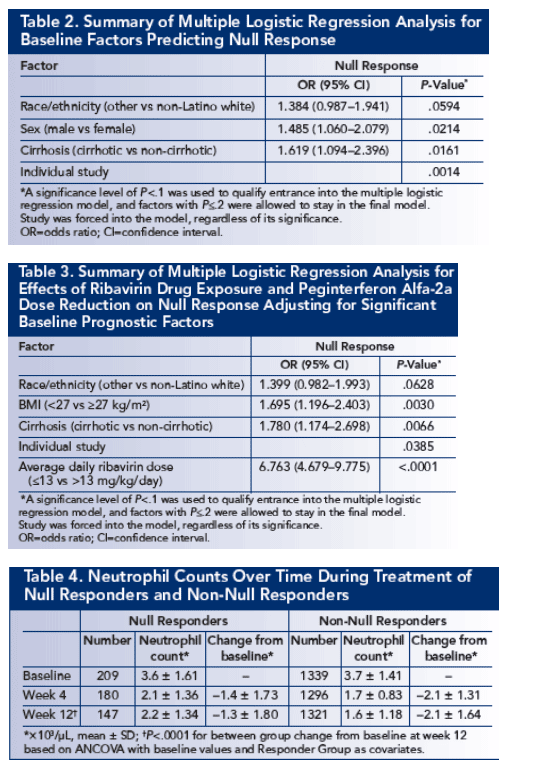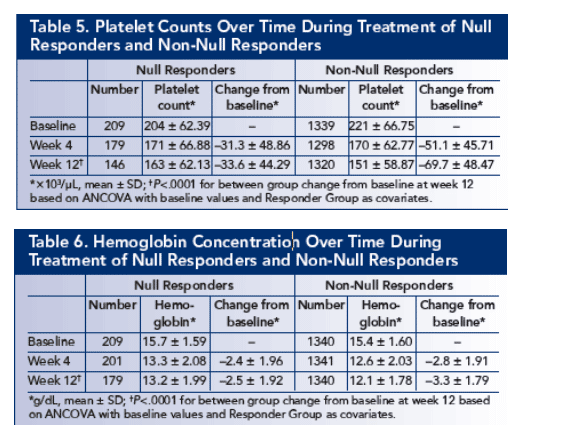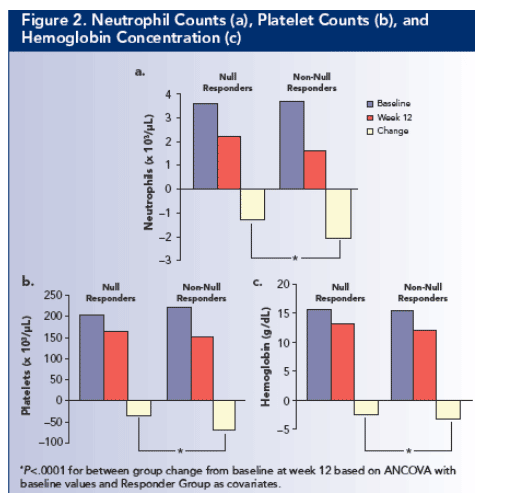 |
 |
 |
| |
Association of Pre-Treatment and On-Treatment Factors With Null Response in Patients With Chronic Hepatitis C Treated With Peginterferon Alfa-2a and Ribavirin
|
| |
| |
Reported by Jules Levin
43rd EASL
April 23-27, 2008
Milan, Italy
Adrian M. Di Bisceglie, MD1; Tarek Hassanein, MD2; Lennox J. Jeffers, MD3; Fayez M. Hamzeh, MD, PhD4; Karen L. Lindsay, MD5; Raymond T. Chung, MD6
1Saint Louis University School of Medicine, St. Louis, MO; 2University of California San Diego, San Diego, CA; 3University of Miami, Miami, FL; 4Roche, Nutley, NJ;
5University of Southern California, Los Angeles, CA; 6Massachusetts General Hospital, Boston, MA
INTRODUCTION
Treatment with peginterferon alfa-2a plus ribavirin for 48 weeks produces a sustained virologic response (SVR) in 46-63% of patients infected with hepatitis C virus (HCV) genotype 11, 2
Current treatment guidelines include a 12-week stopping rule; ie, that treatment be stopped in HCV genotype 1-infected patients who do not achieve a ≥2 log10 decrease from baseline HCV RNA concentration after 12 weeks of treatment
Although most patients who do not achieve SVR have partial response or relapse, some show a <1 log10 decline in serum HCV RNA after 12 weeks (Null Responders)
Pharmacodynamically, patients who show a null virologic response may also show non-responsiveness when assessed for changes in hematologic parameters, such as neutrophil and platelet counts and hemoglobin concentrations
This retrospective analysis assessed the baseline and on-treatment factors associated with null response
CONCLUSIONS
Baseline factors associated with null response include race/ethnicity, sex,
BMI, and cirrhosis
Mean daily ribavirin exposure of less than 13 mg/kg/day is associated with higher likelihood of null response
Although limited information is available on Null Responders, observed trends were consistent with previous findings
DISCUSSION
Importance of characterizing predictors of null response
- Current 12-week stopping rule states that treatment be stopped in patients who do not achieve early virologic response (EVR)
- Relative to treatment for 48 weeks, extension of treatment to 72 weeks has been shown to significantly increase SVR rates in patients infected with HCV genotype 1 who did not achieve EVR at week 126, 7
- Regardless of these latter findings, however, it is not likely that Null Responders, who show minimal reduction in viral load after 12 weeks, would show SVR with longer treatment
- Thus, by identifying Null Responders, unnecessary treatment can be avoided
Null response of HCV genotype 1-infected patients to 12 weeks of treatment with
peginterferon alfa-2a plus ribavirin was associated with race/ethnicity other than
non-Latino white, male sex, BMI >27 kg/m2, and baseline cirrhosis
Patients exposed to ≦13 mg/kg/day ribavirin were also more likely to be Null Responders
These findings support kinetic modelling concepts which suggest that ribavirin enhances the pharmacodynamic reduction in HCV RNA in patients treated with pegylated interferon8, 9
The analysis suggested that peginterferon alfa-2a dose reduction may not have an effect on null response. The number of patients who required peginterferon alfa-2a dose and magnitude of reduction may have been a limitation
Non-null response was associated with significantly greater decreases from
baseline hemoglobin concentrations and in neutrophil and platelet counts at week 12, suggesting that virologic response to peginterferon alfa-2a plus ribavirin was associated with hematologic response to these agents
In these Null Responders, the pharmacodynamics of the drugs showed consistent unresponsiveness in efficacy as well as in hematologic safety parameters
This retrospective analysis allowed us to characterize Null Responders by pooling multiple studies which evaluated more difficult to treat subpopulations of HCV patients
RESULTS
Of 1550 treated patients, 209 (13.5%) were Null Responders (ITT analysis, Table 1)
Baseline factors of Null Responders in the ITT (patients without 12-week HCV RNA considered Null Responders), observed (patients without 12-week HCV RNA excluded), and last observation carried forward (LOCF) analyses were similar (not shown)
Patient demographic and baseline characteristics of the entire cohort, and of Null Responders and Non-Null Responders in the ITT population, are shown in Table
Figure 1 shows the null response and non-null response rates in the 5 individual
studies used for this analysis
Of 1550 patients, 47 patients (3.0%) withdrew for adverse events (AEs) or laboratory abnormalities, and 44 (2.8%) withdrew for non-safety reasons which included: 2 (0.1%) for violations of inclusion criteria; 3 (0.2%) for other protocol violations; 22 (1.4%) who refused treatment, did not cooperate, or withdrew consent; 12 (0.8 %) who failed to return; 4 (0.3%) for administrative or other reasons; and 1 (0.1%) for an insufficient therapeutic response. By definition of ITT analysis, all the dropouts were classified as Null Responders
Multiple logistic regression analysis of the ITT population showed that race/ethnicity with the exception of non-Latino white (odds ratio [OR] 1.384; 95% CI, 0.987-1.941, P=.0594), male sex (OR 1.485; 95% CI, 1.060-2.079, P=.0214), baseline cirrhosis (OR 1.619; 95% CI, 1.094-2.396, P=.0161) and individual study (P=.0014) were significant risk factors for null response (Table 2)
After adjusting for significant risk factors in the baseline characteristics model, multiple logistic regression analysis of the ITT population showed that, compared with an average daily dose of ribavirin over 12 weeks of >13 mg/kg/day, an average daily dose of ribavirin of ≦13 mg/kg/day (OR 6.763; 95% CI, 4.679- 9.775, P<.0001) was a predictor of null response (Table 3)
In contrast, peginterferon alfa-2a dose reduction was not a predictor of null
response
Hematologic Findings
Neutrophil counts (Figure 2a and Table 4), platelet counts (Figure 2b and Table 5) and hemoglobin concentration (Figure 2c and Table 6) at week 12 showed significantly (P<.001) greater decreases from baseline in Non-Null Responders than in Null Responders
METHODS
Analysis included patients in 5 clinical trials (NV15801, NV15942, NR16172, ML18179, ML17756) who were infected with HCV genotype 1 and randomized to treatment for 48 weeks with 180 ug/week peginterferon alfa-2a plus 1000 or 1200 mg/day ribavirin1-5
- Three of these trials were enriched with patients who had characteristics traditionally associated with a decreased treatment response:
· 100% high viral load (>800,000 IU/mL)3
· 74% black race4
· 47% white Latino ethnicity5
Patients were divided into two groups, depending on whether or not they showed null virologic response at week 12:
- Null Response Group, defined as patients with <1 log10 decrease in serum HCV RNA from baseline at week 12 of therapy
- Non-Null Response Group, defined as patients with ≥1 log10 decrease in serum HCV RNA from baseline at week 12 of therapy
Baseline demographic and clinical factors used for stepwise multiple logistic regression analyses included:
- Age (≦40 vs >40 years)
- Sex
- Race/ethnic group (white non-Latino vs other)
- Body mass index (BMI) (≦27 vs >27 kg/m2)
- Baseline alanine aminotransferase (ALT) quotient (≦3 vs >3X upper limit of normal [ULN])
- Baseline serum HCV RNA (≦400,000 vs >400,000 IU/mL)
- Cirrhosis classification (cirrhotic vs non-cirrhotic)
- Individual study as a factor
The final model was based on the multivariate stepwise logistic regression with entry and exit criteria of P<.1 and P>.2, respectively. Wald chi-square confidence intervals and P-values were used for testing the effects. To account for the study difference, individual study was forced into the model regardless of its
significance level
Additional multiple variable logistic regression analyses included:
- Adjusting for significant baseline prognostic factors and investigating the
association of the following on-treatment characteristics with null response:
· Average daily exposure to ribavirin (≦13 vs >13 mg/kg)
· Peginterferon alfa-2a dose reductions (yes vs no)
- Patients with any dose reduction (taken from the CRF dose administration) during the first 12 weeks, regardless of reasons, were classified as dose reduced
All factors were also evaluated by descriptive tabulation by the baseline factors. For percent of null response, three ways of handling missing week 12 HCV assessment were used, ie, 1) treating all missing values as Null Responders, 2) last value carried forward, 3) observed case only, to investigate the impact of missing values on response rate
Changes in neutrophil counts, platelet counts, and hemoglobin concentration for the Null Responders and Non-Null Responders were compared
By definition, Non-Null Responders had an HCV assessment at week 12 showing a ≥1 log10 decrease from baseline. All dropouts were classified as Null Responders in the intent to treat (ITT) analysis. Drug exposure, reasons, and timing of dropout during the first 12 weeks of treatment were evaluated




|
| |
|
 |
 |
|
|